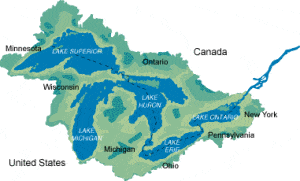Saturday, July 18th, 2015
Author: Arnie Gundersen
Source: fairewinds.org
Publication Date: July 16, 2015
Link: Downstream
Stephan: Arnie Gundersen, in the four years since the Fukushima meltdown crisis, which is still spewing hundreds of thousands of gallons of radioactive water into the Pacific Ocean, has become the single most authoritative fact-based voice of reason about nuclear power, and its future prospects. In this report he discusses something that only people in the nuclear power community are aware of or have considered: What would happen if any one of the 30 aging nuclear reactors along the shores of the Great Lakes were to have a similar meltdown? Here is his assessment beginning with this based on past data: "History shows that there will likely be a nuclear meltdown about once every seven years."
We have aging nuclear power plants all over the United States, and no one in power seems to be thinking through how these aging catastrophes in the making are going to be shut down and their waste made safe. Quite the contrary, the nuclear power industry blinded by greed is actively lobbying for more to be built. After you read this essay by Gunbdersen you may not feel that is a good idea.

Credit: fairewinds.org
More than four years after the triple meltdown at Fukushima Daiichi, many radioactive isotopes created inside the reactors as nuclear waste, including cesium, strontium, and plutonium, continue to bleed into the Pacific Ocean. Even though the Pacific Ocean contains more than 700 million cubic kilometers of water, low concentrations of radioactivity have already migrated across the Pacific to the Vancouver and Alaskan coasts as Fukushima Daiichi slowly contaminates the largest body of water on Earth.
The Pacific Ocean is 30,000 times larger than all the Great Lakes combined, and the once pristine watershed of the Great Lakes is now home to 30 nuclear power reactors. Eighteen of these nuclear reactors have the unique Canadian CANDU design and are located in Ontario Province at Bruce (8), Pickering (6) and Darlington (4), while 12 are US designs located at nine site locations in Michigan, New York State, Ohio, and Wisconsin. In addition, several temporary nuclear waste storage sites on Lake Huron near the Bruce site are in imminent danger of becoming permanent nuclear waste dumps that will be abandoned underground within one mile of […]












I do not believe our US government would even tell us about any leaks. They are all so narcissistic that they really do only care about their own personal wealth and false sense of power that they will do nothing and let us all die a horrible death and that will continue for generations. If only they had a “true” religion that respects the earth first we might be able to solve it. That is what Tom Shadyac tried to explain in his wonderful documentary called “I AM” which my wife and I just watched last night. In the movie he explains the human situation of our lack of understanding of the premise that EVERYTHING is connected. He’s doing his part. I am trying to do mine. Are you readers out there trying to do your part? I know Stephan S. is doing his best, but it will take ALL of us to make the world sacred again the way it used to be before Europe invaded the North American beauty and ruined it. Let’s all pledge to do our best. OK?